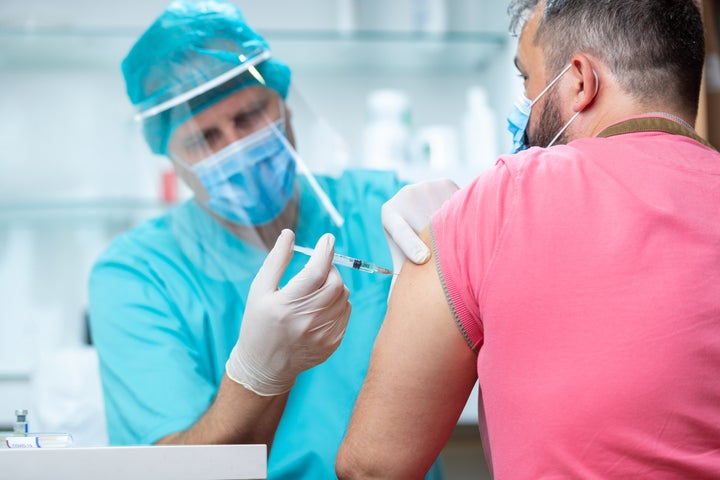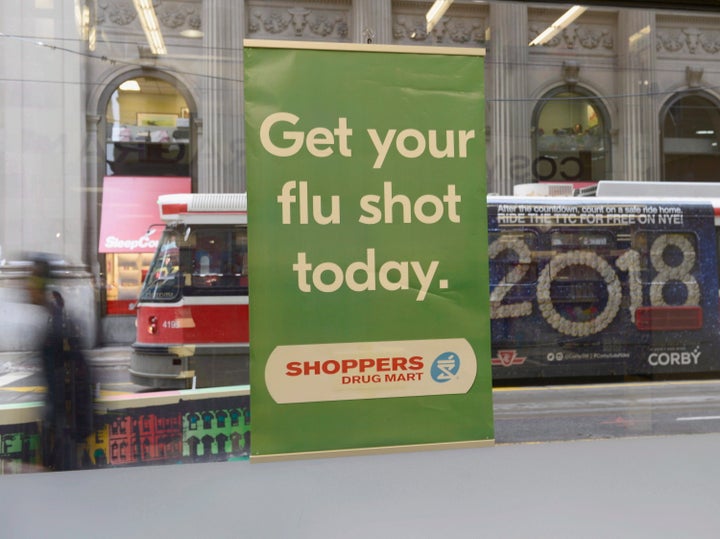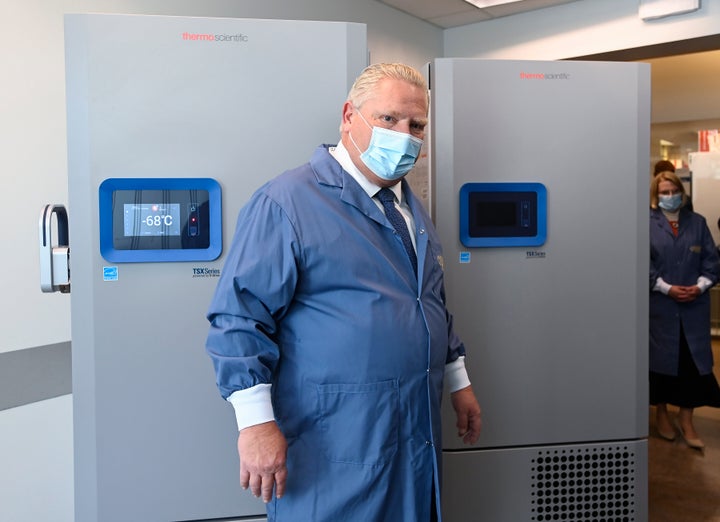The time we’ve all been waiting nearly a year for is finally here — COVID-19 vaccinations begin across Canada next week.
The approval of the Pfizer vaccine by Health Canada opens the door for our country’s largest vaccination campaign in its history. It also opens the door to the end of all of this — or at least some sense of closure on it.
The news had many Canadians fantasizing about that blessed day when things return to a semblance of normalcy, whether it’s crowding into packed karaoke bars, hugging our loved ones, or grocery shopping mask-free. For the first time in a long time, there’s hope.
But for many Canadians, the next year is going to be about patience — a LOT of patience.

That’s because while the vaccine is beginning to arrive, people are actively getting vaccinated on Canadian soil starting next week, and Canada’s procured millions more doses, it will take a long time for all of those needles to reach Canada and get distributed to everyone who wants it. There’s a process, and following it will mean saving lives.
Canadian health officials have repeatedly indicated that everyone who wants to will be vaccinated by the end of 2021. The road to get there — and to that freedom to share fishbowl cocktails and dance at a crowded wedding and sing Shania Twain karaoke — will take time.
Canada’s most vulnerable
The priority right now is the groups who actively need the vaccine — we’re talking health-care workers and society’s most vulnerable. The New York Times developed a handy tool to see where in line you’d be in the United States. Each province’s specific roll-out plans are a bit different, but here’s a non-exhaustive list of key groups identified as priorities for vaccinations, by both federal and provincial officials:
- long-term care residents
- long-term care workers
- other health-care workers
- front-line workers like grocery store clerks or teachers
- the elderly
- immunocompromised and high risk folks
- people in close contact with the above
For many Canadians none of those categories apply. I’m 25 years old, relatively healthy and worked from home even before the pandemic. If there was a paper list of one to 38 millionth for vaccinations, I’d be right at the end of it. A lot of people fall into that big chunk of the population alongside me. We’ve waited in anticipation, and we’re going to have to wait a little longer.
According to Ontario Premier Doug Ford, the vaccine should be “widely available” by April. But it won’t be as simple as waltzing into your local Shoppers and getting your shot on April 1. For a possible glimpse of what this might be like, look to the recent influenza vaccination campaign.
Getting a flu shot — two months later
Ahead of the winter months, Canadians were urged to get our flu shots. And we largely did, turning up in record droves to get immunized and prevent dual diseases ravaging our country. And even though officials reported no major vaccine shortages, it was still a bumpy road as supplies in certain regions fluctuated.
As planned with the COVID-19 vaccine, the most vulnerable got it first, with high-dose Fluzone vaccines being administered in long-term care and health-care settings. The rest of us had to chase open appointment slots at our local pharmacies on our own time.
I went to three different pharmacies here in Vancouver in one day that indicated online they had flu vaccines available. Every time I arrived to see that location had run out. All the while, London Drugs let me register online for a spot on the waitlist, based on my age and health status.

This week, a month and a half after I put my name down with London Drugs for their waitlist, I got an email saying it was my turn to book an appointment. I went on my lunch break, got my flu shot and bought myself a fancy coffee to celebrate. It was probably two months later than I ideally would’ve gotten the shot, but I got it.
And that’s fine! It’s important that the people who need it most get it first. I was at low risk of getting, transmitting or experiencing adverse effects of the flu. During those two months I did basically what I’ve been doing this whole pandemic — stayed home, worked from home and baked a lot. That puts me at pretty low risk of getting or spreading the flu.
When I could get my shot, I did it in a low-hassle affair with no huge lineups or wait times. I got my appointment, and I went and did it.
Now flash forward to the COVID-19 vaccine. The roll-out will be a lot more structured than the influenza campaign, but it will have similarities. Certain groups will be prioritized, and at some point it will open up to the general public. And while there are legitimate concerns about convincing hesitant folks and anti-vaxxers to jump on board, we also should worry about the crush of people rushing to get it.
As various COVID-19 vaccines roll out, society will bear to witness some of the best and worst of people. As with all things, money and power will let people jump the line ahead of those who need it most. Already, reports say the NHL is considering privately secured doses for all players and personnel ahead of the 2021 season.
The league quickly clarified that they don’t intend to jump the line.
On Friday, Prime Minister Justin Trudeau was asked about the NHL and private vaccines.
“The priority is of course vulnerable Canadians and specific groups. Nothing any private company or organization can negotiate, if they choose to do so, will in any way impact or slow down the delivery of vaccines to Canadians, for free, with vulnerable Canadians at the front of that line,” he said.
But that doesn’t mean others won’t try — here’s looking at you, Trump family. And there is precedent in the NHL. In 2010, Alberta Health had to apologize after members of the Calgary Flames secretly got H1N1 vaccinations ahead of seniors and other vulnerable populations.
The coming months will be a challenge for public health agencies trying to vaccinate the groups that need it most, while the powerful and wealthy try to jump the line.
A global issue
Canada as a country is complicit in this, too. As a wealthy country, we’ve spent millions of dollars to secure more vaccine doses per capita than any other country. Canadians will be among the first vaccinated because of these deals — we currently have up to 414 million vaccine doses ordered through seven purchase agreements for a country of around 38 million people.
But as for the rest of the world? A recent vaccine modelling report from the Center for Global Development estimated that there would not be enough doses to vaccinate everyone until 2023. Many poorer countries will be dependent on places like Canada to donate or fund their share of the vaccine — only after Canada’s taken care of itself, of course. So while you might be planning for next Christmas to be “back to normal,” it’s a very real reality that the pandemic won’t go away that quickly globally.
“As a wealthy country, we’ve spent millions of dollars to secure more vaccine doses per capita than any other country.”
Look to the world’s other ongoing pandemic — the AIDS crisis. It’s often viewed as an “African” issue despite the prevalence of HIV/AIDS in places like North America, because medication and testing and treatment are more accessible here, and that’s tied to wealth.
Even within Canada, the rollout of the COVID-19 could exacerbate regional and societal class divides even more. Provinces are jostling for their share of the federal procurement. Once vaccination is open to the broad public, those with car access or who live in urban centres are more likely to have access to the vaccine — the Pfizer vaccine must be stored at frigid temperatures requiring special freezers. Urban middle and upper class people likely have more spare time to wait in a lengthy line, as opposed to the minimum-wage essential worker working three jobs and looking after their kids.

Social media will fuel this too. The wealthy could share “vaccine selfies” on Instagram of them getting their shot, while it’s still not available to workers in Canada’s far north. In the coming months we’ll likely see Khardashian private island parties justified with cutesy social media messages noting that everyone was vaccinated. Vaccine doses — whether legitimate or not — will command a high price on the Internet market, especially if jurisdictions introduce “vaccine passports” or other restrictions letting only the vaccinated participate in certain activities.
And within the rules, people will try to find loopholes, just the same as they have amidst COVID-19 restrictions. Don’t be surprised if people find ways to qualify as “essential workers” even if they aren’t in order to jump the line.
We all want to see our friends. To hug our parents. To return to the activities we love. Oh, what I would give to head to my local game store on a Friday night and play Magic The Gathering with a crowd of people I don’t know. What I would give to get on a plane and leave the public-transit-accessible world I’ve lived the past year in.
Those of us who can afford to be patient are going to have to be patient. As B.C.’s Dr. Bonnie Henry says often, we’re going to have to be kind, be calm and be safe. As individuals and the government, we must empower and support those who need it most in getting the vaccine as soon as possible.
Don’t rush, don’t panic and do wait your turn. Your turn will come — the vaccine really is here, it really does work, and there really will be enough for everybody eventually (wow, it felt good to write that). But right now, in three months, even in six months, may not be your turn.
“As individuals and the government, we must empower and support those who need it most in getting the vaccine as soon as possible.”
You might have to watch your friends and family go ahead of you as health officials call on the elderly or essential workers to get vaccinated. You’re going to watch people try to jump the line. But watch knowing your time will come.
And know that if you’re being told to wait, it’s likely so someone grandma or your kid’s teacher or the bus driver can get it before you. Our patience will save lives.
So hunker down, bake some sourdough and get ready. The wait is almost over, but a lot of us are going to have to wait a little while longer.